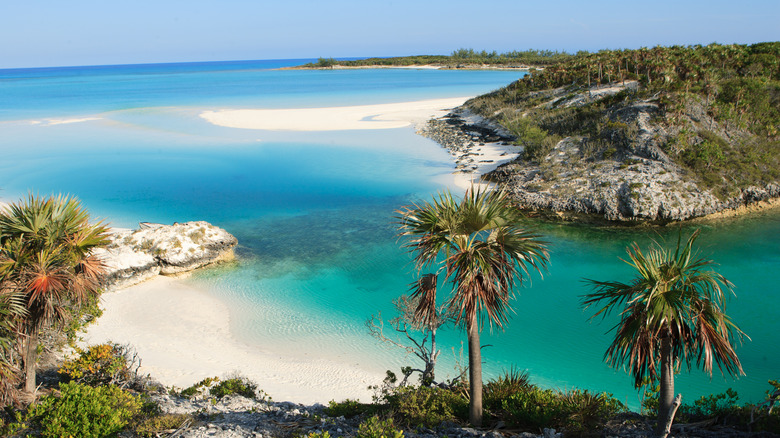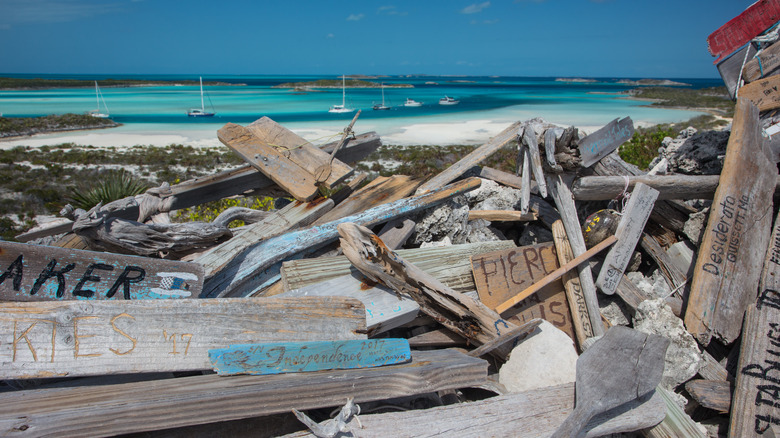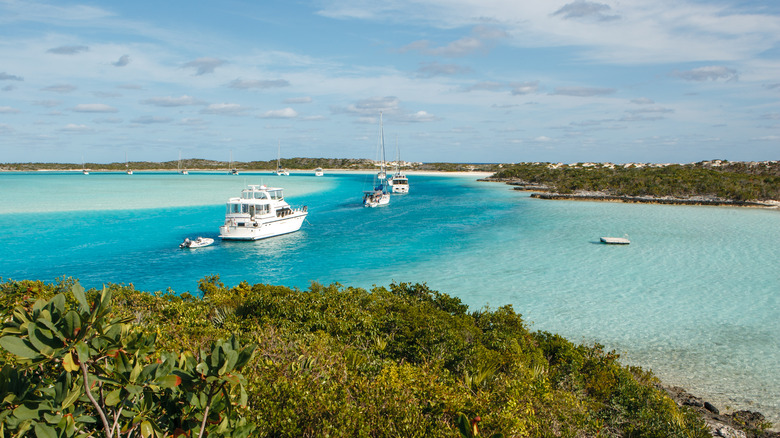The Bahamas' Oldest National Park Is A Pristine Group Of World-Famous Islands Only Accessible By Boat
When you see those iconic photographs of the beautiful Bahamas, chances are they were taken in a singular place: the Exuma Cays. Further, chances are it was taken in a unique part of those cays — the Exuma Cays Land and Sea Park. Gin-clear water, more shades of blue than you knew possible, and lazy days strolling the beach or diving the reef await at this slice of Bahamian paradise.
The Exuma Cays Land and Sea Park occupies a 22-mile stretch of islands and all the surrounding waters — over 100,000 acres in total. It includes a wide range of ecosystems, from large cays and small rocks to sandbars and coral reefs, plus the shallow-water Bahamas Banks and the deep waters of Exuma Sound. The major islands included in the park are (from north to south) Shroud, Hawksbill, Cistern, Warderick Wells, O'Brien's, and Bells. But getting to see these gems isn't easy; they're not near any major towns. Nassau is about 40 miles to the northwest. The park has no development, but private islands, exclusive resorts, and the small settlement on Staniel Cay are nearby.
The remoteness is, of course, part of what makes the place special. You have to really want to get to the Exuma Cays Land and Sea Park; it's not a causal thing you can just do for a few hours. It's the perfect place to explore with a cruising boat for a few days or weeks. While many excursion tours depart Nassau or Great Exuma for the "Exuma Cays," very few of them actually visit the Land and Sea Park. Many let you see the famous swimming pigs or other popular attractions, but the tour operators frequent other cays. If you want to visit the park, your best bet is a private charter.
Paradise isn't paved in the Exuma Cays
The islands in the park are some of the most pristine and untouched in all of the Bahamas simply because they've been a protected area for so long. The park is the nation's oldest, formed in 1958 when local conservationists worked to save a part of the Exumas from development. It was the first marine protected area in the world and the first no-fishing zone in the Caribbean region. It has been a model for other locations worldwide. In 2018, according to the Bahamas National Trust, it won the Platinum Global Ocean Refuge Award, noting that it "meets the highest science-based standards for biodiversity protection and best practices for management and enforcement."
The Exuma Cays Park has always been a place of preservation — a stricter form of conservation that seeks to minimize human impact. In other words, the entire park is a no-take zone — no fishing, lobstering, conching, or even shelling. The park is serious about enforcement, too, with a detachment of Royal Bahamas Defense Force officers permanently stationed there to ensure the rules are followed.
So don't come to the Land and Sea Park to go fishing; come to enjoy some of the best snorkeling spots in the Bahamas, the countless beaches, or the miles of gleaming white sandbars. Hiking on the larger islands offers vistas of the beautiful cays. Miles of trails snake their way around the park headquarters on Warderick Wells Cay. From the shrub-covered cliffs, you can glimpse amazing views of the surrounding waters, colored in every imaginable shade of blue. One trail leads you to the top of Boo Boo Hill — a windswept overlook where passing boaters leave driftwood markers of their arrivals.
Exploring the Exuma Cays Land and Sea Park on your own
For boaters traveling from Florida to the Exumas, the park makes a natural stopover point. Cruising boats allow visitors to stay the night in one of the most beautiful environments on Earth and spend their days island hopping and exploring the numerous beaches and mangrove creeks. If you're flying into Nassau, you can experience this lifestyle with bareboat or crewed yacht charters in the Bahamas through The Moorings or other companies. If you're into diving, there are several liveaboard dive boats, like the Cat Ppalu, that spend several days cruising the cays.
No matter how you get to the Park, you've got to be prepared to be self-sufficient. There are no hotels, restaurants, grocery stores, or marinas. There isn't even very good cell service. Aside from a few buildings used by park management, the islands are entirely undeveloped, as nature intended them to be. That is, after all, what this park is all about. Boaters stay anchored off the islands or swing on park-provided moorings. Day visitors can come from the neighboring islands, some of which host exclusive resorts like romantic getaway Fowl Cay, the settlement at Staniel Cay, or the postcard-perfect beaches of Norman's Cay. Several local guides, like Staniel Cay Adventures, offer tours of the park.
The Exumas are a year-round paradise for island hoppers, whether you're coming by air or sea. Average temperatures are in the 70s and 80s every month of the year. Winters tend to be windier, with better sailing, while summers are calmer and ideal for diving adventures and cruising on powerboats. Water temperatures vary from 76 degrees Fahrenheit in early February to 85 in late August. Hurricane season runs from June through November, but the majority of storms occur between late August and early October during the season's peak.


